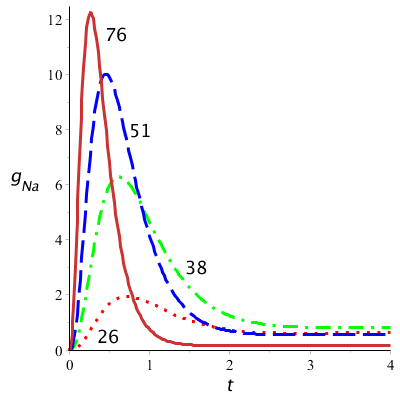Bioelectricity: Electric excitability and action potential
 Voltage-dependent conductivity of sodium channels
Voltage-dependent conductivity of sodium channels
Measurements of Hodgkin and Huxley in voltage-clamp experiments
The diagram below shows the points measured by Hodgkin and Huxley in their voltage-clamp experiments in which the conductivity of sodium channels for various imposed voltages are plotted in the course of time (always in their own coordinate systems). Recall that this is always a step-wise increases in the imposed voltage (as noted on the right-hand side of the curves) and involves the reaction of the membrane hereto. For the conductivity \(g_\mathrm{Na}\) we have: \[g_\mathrm{Na}=\frac{V_m-E_\mathrm{Na}}{I_\mathrm{Na}}\] i.e. \[I_\mathrm{Na}=g_\mathrm{Na}(V_m-E_\mathrm{Na})\] The measured data at an imposed voltage are always modelled with a mathematical formula of which the graph is drawn. The graphs describe the measured data quite well.
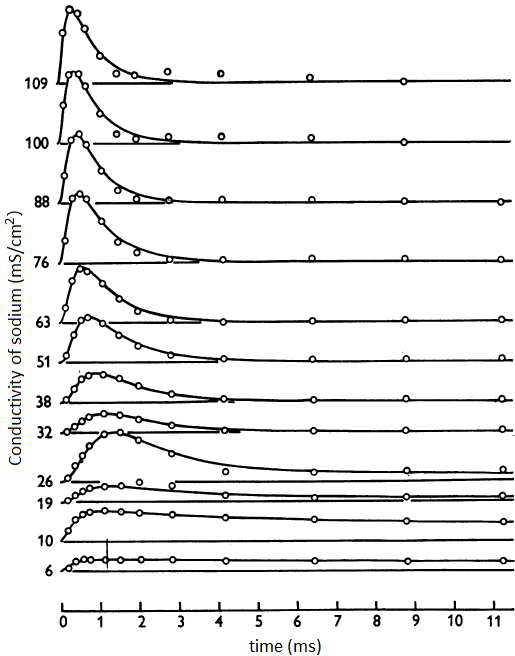
Normalization
The graph of the conductivity \(g_\mathrm{Na}\) of sodium channels for increasing voltage is more complicated than that of potassium channels: now the conductivity initially increases but subsequently it decreases again, with a maximum that is reached within 1 millisecond. When you normalize these graphs they are in fact all of the same form (see the diagram below). Normalization is actually nothing more than writing the conductivity \(g_\mathrm{Na}\) as the product of the maximum conductivity, say \(\overline{g_\mathrm{Na}}\), and a function \(p_\mathrm{Na}(t)\) : \[g_\mathrm{Na}=\overline{g_\mathrm{Na}}\cdot p_\mathrm{Na}(t)\] This function \(p_\mathrm{Na}(t)\) is the normalized conductivity of sodium channels. This enabled Hodgkin and Huxley to propose a formula for conductivity of sodium channels as a function of voltage and time. However, the physiological interpretation through a gate mechanism is now more complex than that of the potassium channel, which was based on an open or closed state per channel with four gating particles of the same type involved. We now assume not two but three states for an ion channel: open, closed and inactivated. Now still four gating particles play are role but we distinguish two types: one for open/closed state and one of inactivated/not inactivated.
The figure below symbolizes the differences in the state of potassium and sodium channels in case of hyperpolarization and depolarization. Potassium and sodium channels are closed in a state of hyperpolarization. At depolarization the sodium channel opens first and hereafter the potassium channel opens. The potassium channel closes again when the membrane voltage decreases. For the sodium channel this is different: in continuous depolarization the ion channel becomes inactivated (as if a second door in the hallway closes) and no ions can pass.
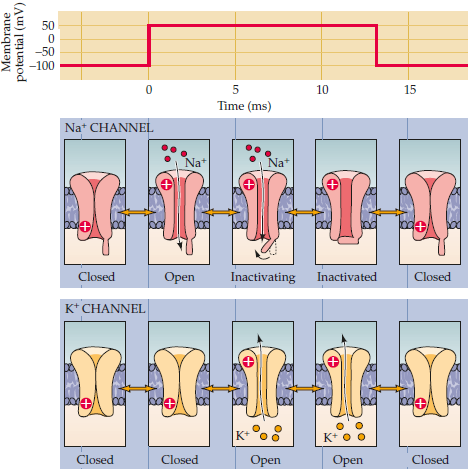
mathematical model
The basic idea is to first establish a mathematical model where \(\overline{g_\mathrm{Na}}\) is the maximum conductivity of sodium channels when all sodium channels are open, and \(p_\mathrm{Na}\) symbolizes the fraction of open sodium channels. Hodgkin and Huxley assumed that three components of a potassium channel must be in permeable mode in order to have ionic flow through the ion channel, with the probabilty \(m(t)\) per component, and that one component must be in a 'not inactivated' mode, with the possibility \(h(t)\). Once again, Hodgkin and Huxley assumed that the stochastic processes are independent. This gives the formula \[p_\mathrm{Na}=m^3h\] In analogy with chemical reaction kinetics Hodgkin and Huxley assumed that there is an 'equilibrium reaction' is non-transmissive to the transmitting state and vice versa with 'reaction constants' \(\alpha_m\) and \(\beta_m\), plus \(\alpha_h\) and \(\beta_h\), respectively, in a model of elementary reaction equations. The indices indicate which component of the ion channel is involved. As before when we described conductivity of potassium channels we get differential equations of limited exponential growth. For \(m(t)\) we have \[\frac{\dd m}{\dd t} = \alpha_m(1-m) - \beta_m m\] and it has as a solution for the initial value \(m(0)=0\) (chance of permeability equal to 0) \[m(t) = m_\infty\cdot \left(1-\exp\bigl(-\frac{t}{\tau_m}\bigr)\right)\] where \[m_\infty = \frac{\alpha_m}{\alpha_m+\beta_m}\quad\mathrm{and}\quad \tau_m=\frac{1}{\alpha_m+\beta_m}\] For \(h(t)\) we have \[\frac{\dd h}{\dd t} = \alpha_h(1-h) - \beta_hh\] and it has a solution for the initial value \(h(0)=1\) (chance of not inactivated state equal to 1): \[h(t) = h_\infty\cdot \left(1-\exp\bigl(-\frac{t}{\tau_h}\bigr)\right)+ \exp\bigl(-\frac{t}{\tau_h}\bigr)\] where \[h_\infty = \frac{\alpha_h}{\alpha_h+\beta_h}\quad\mathrm{en}\quad \tau_m=\frac{1}{\alpha_h+\beta_h}\]
Voltage dependence
Hodgkin and Huxley proposed, on the basis of their measurements, the following formulas for the voltage-dependent parameters (in units of \(\mathrm{ms}^{-1}\) and \(\mathrm{mV}\)): \[\begin{aligned} \alpha_m&= \frac{0.01(25-v)}{\exp\left(\frac{25-v}{10}\right)-1}\\ \\ \beta_m&=4\exp\left(\frac{-v}{18}\right)\\ \\ \alpha_h&=0.07\exp\left(\frac{-v}{20}\right)\\ \\ \beta_h &= \frac{1}{\exp\left(\frac{30-v}{10}\right)+1} \end{aligned} \] where \(v\) the difference between the voltage and the resting membrane voltage \(V_r=-70\;\mathrm{V}\) is. When you do not want to express the voltage dependency relative to the resting membrane potential but instead study it relative to the membrane potential then you need to replace \(v\) by \(V-V_r=V+70\).
When we apply the above formulas we can plot the time constants \(\tau_m\) and \(\tau_h\) and the steady-state values \(m_\infty\) and \(h_\infty\) against voltage \(v\) and watch the voltage dependence in graphic form:
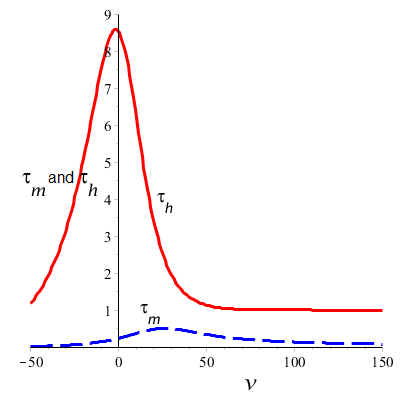
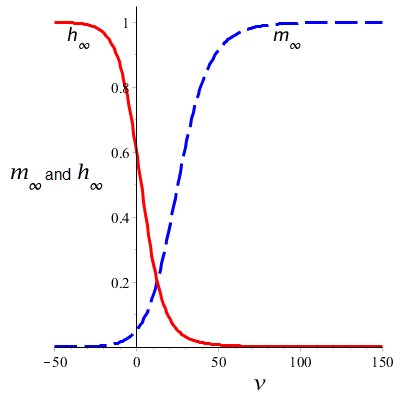
The bottom graph shows that at depolarization (positive \(v\)), the steady-state value \(m_\infty\) increases, and the steady-state value \(h_\infty\) decreases when the voltage increases. At polarization (negative \(v\)) it is exactly the opposite: then the steady-state value \(m_\infty\) is small and the steady-state value \(h_\infty\) is large. The two gate mechanisms appear to work against each other.
The upper graph shows that the time constant \(\tau_h\) has a maximum around the resting potential and that the time constant \(\tau_h\) has a maximum during depolarization. Furthermore, it is striking that the time constant \(\tau_h\) is much smaller than the time constant \(\tau_h\), suggesting that this gate mechanism responds more quickly to variations in voltage than the gating mechanism that controls inactivation. At depolarization time constant \(\tau_h\) decreases when the voltage becomes larger and this decrease becomes smaller and smaller with increasing voltage. For the time constant \(\tau_m\) it is different: first, this time constant first increases at polarization and then it decreases again at stronger polarization. It is important to realize that the conductivity of sodium is a combination of two mechanisms.
Below are shown graphs of the model curves of sodium conductivity plotted against time for different values of \(v\). We used the following value for the maximum conductivity: \(\overline{g_\mathrm{Na}} =120\;\mathrm{mS\,cm}^{-2}\) We have further assumed that \(m(0)=0\) and \(h(0)=1\). They look like the measurement curves in the first diagram made by Hodgkin and Huxley.
